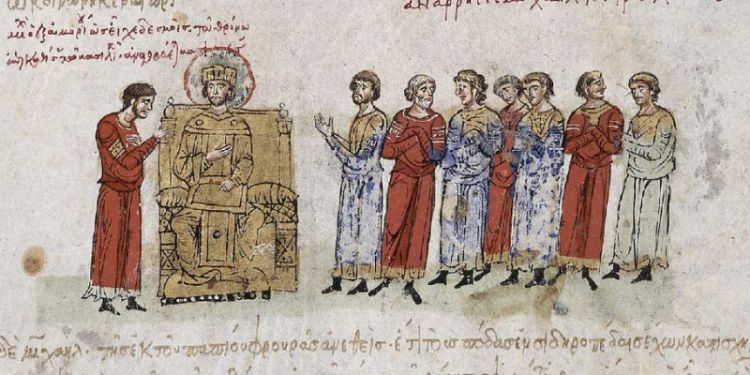Research project
A Cultural History of Disability in Byzantium, c. 1000-1200
- Start date: 23 May 2022
- End date: 22 May 2026
- Funder: Wellcome Trust
- Primary investigator: Dr Maroula Perisanidi
Description
A successful scholar who has a stutter.
An emperor who experiences chronic pain.
A military general who is blind.
A priest with restricted mobility who celebrates the liturgy.
These are some of the people we find in Byzantine history. Although Byzantium was not free from ableism, its different conception of the body, religion, autonomy, and the human/animal divide present us with a diverse terrain that challenges conceptions of disability as deficit or tragedy.
This project focuses on the eleventh and twelfth centuries to centre the contributions of disabled people in Byzantine society and reframe disability as a gain that enriches human experience.
Research overview
This project is structured along four research themes
Terminology
The Byzantines had no word for ‘disability’ and used various terms to describe human variance. I am collecting these terms and comparing them to ancient Greek terminology to assess the impact of classical influences and reveal groupings that may have led to shared experiences of stigma amongst people with different disabilities. As part of this analysis, I am investigating how some of the most frequently used modern English translations perpetuate ableist historiographical assumptions.
The Church
Religion played a crucial role in Byzantine attitudes towards disability. Using saints’ lives and canon law, I am interrogating the association of disability with sin, paying particular attention to questions of sexuality and heredity, and providing comparisons with Western medieval material. Using contemporary school books, I am examining the influence of the ancient Greek idea that impairments were accompanied by artistic talent and its adoption within a religious context that valued sensory deprivation as a gateway to spiritual sensation. I am also exploring how the Byzantines reinterpreted features that were considered comic in Classical mythology — such as the fact that the ancient god Hephaistos apparently had a club foot — given the Church’s disapproval of certain types of laughter, especially those that resulted from irreverent speech.
The Court
Secular attitudes towards disability emanated from the imperial court: the centre of power, performance, and display. Imperial entertainment included the exhibition of a little person, and jester-like behaviour centred around bodily difference. I am considering how far Byzantine disabled people could use their bodies as a source of empowerment that helped them attract imperial favour. While highlighting their agency, I will question whether strategies of ‘enfreakment’ reproduced and reinforced normative notions of able-bodiedness. I am investigating these ideas within the wider context of hypocrisy and performance in Byzantium, and draw comparisons with attitudes towards disabled emperors and palace eunuchs, who present a prime example of disability gain .
The Posthuman
Byzantine sources can help us rethink the traditional humanist ideal of autonomy and its relationship to disability. Although independence was an important masculine ideal in the Byzantine world, by focusing on the material entanglements of humans, non-human animals, and technology, we can map alternative models of engagement with the world, guided by interdependence and expanded notions of the body. A knight and his horse or a scholar and his writing chair are examples of assemblages which extend the human body and shape human subjectivity. In the case of disabled people, the horse and the chair can act as (im)mobility aids that recreate through relationality the freedom that is usually associated with the ideals of independence and autonomy.
Glossary of key theoretical terms
Ableism
Ableism has been defined as ‘a network of beliefs, processes and practices that produces a particular kind of self and body (the corporeal standard) that is projected as the perfect, species-typical and therefore essential and fully human. Disability is cast as a diminished state of being human’. See Fiona Kumari Campbell, ‘Inciting Legal Fictions: Disability’s Date with Ontology and the Ableist Body of the Law’, Griffith Law Review, 10 (2001), pp. 42–62, at p. 44, available open access via the Griffith University research repository.
Disability
This is a concept from the discipline of Disability Studies. There is a good explainer article on the University of Washington DO-IT (Disabilities, Opportunities, Internetworking, and Technology) Center website.
Enfreakment
The concept of enfreakment refocuses attention away from a body as inherently different and onto the visual and narrative mechanisms of representation which render this body a ‘freak’. For example, the strategic use of props such as a very tall hat to highlight a person’s short stature.
Posthumanism
Posthumanism questions human exceptionalism: the idea that humans hold a position of primacy above other species. Instead, it emphasises the various ways in which human identity cannot be extricated from non-human beings and their ways of being in the world. Following this line, the myriad non-human ways of perceiving (for example those of animals, plants, or computers) are equally valid and valuable as human ways of encountering and apprehending life. For more on posthumanism, see the definitions on the Science Direct website.
Forthcoming publications
Maroula Perisanidi, Speech Difference and Disability Gain in Byzantium, c. 1000-1200.
Maroula Perisanidi, ‘Gregorios Antiochos: Disabled Bodies and Desired Becomings’ in Masculinity in Byzantium, c. 1000-1200: Scholars, Clerics and Violence by Maroula Perisanidi (Cambridge University Press, 2024).
Maroula Perisanidi and Ilya Maude, ‘Transmisogyny, Ableism and Compulsory Cisness: Case Studies from Byzantium’, Past and Present (published online 2024).


